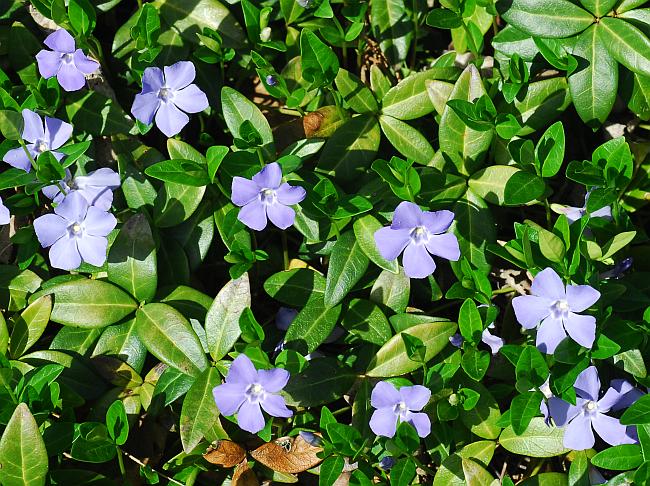Vinca minor L.
Common Periwinkle

Introduced
CC = *
CW = 5
MOC = 23
© SRTurner
Vinca minor L.Common Periwinkle | |
 |
Introduced CC = * CW = 5 MOC = 23 |
© SRTurner |
|
Family - Apocynaceae Habit - Perennial herb, sometimes woody at the base. Stems - Trailing, twining, glabrous or sparsely glandular-pubescent, typically hollow, to 2 m.
Leaves - Opposite, simple, petiolate, evergreen, leathery. Petioles 1-2 mm long, glabrous. Blades 1.8-5.0 cm long, 0.8-2.5 cm wide, lanceolate to ovate, narrowed to a sharply or bluntly pointed tip, angled at the sometimes slightly asymmetrical base, shiny green above, silvery green below, the margins glabrous.
Inflorescence - Solitary axillary flowers. Pedicels 9-12 mm long.
Flowers - Calyx lobes 5, 4-5 mm long, linear-subulate, acute, glabrous. Corollas 2.5-3cm broad, salverform, 5-lobed, bluish-purple, with the tube 8-12 mm long, the lobes 9-14 mm long, glabrous externally, pubescent internally just at throat. Stamens 5, opposite the corolla lobes, adnate at apex of the corolla tube. Filaments green, 2.5 mm long. Anthers yellow, 1.6 mm long, densely pubescent. Style green, 4.5 mm long, glabrous. Stigma densely white-pubescent. Ovary 2-carpellate, superior, 1.4 mm long, green, glabrous, with two opposing nectaries adjacent to the carpels. Nectaries yellowish to purple in flower.
Flowering - April - May. Habitat - Woods, bluffs, waste ground. Origin - Native to Europe. Lookalikes - V. major. Vegtatively similar to Euonymus fortunei. Other info. - This popular cultivated species is found in scattered locations throughout Missouri and the eastern half of the continental U.S. It is easily recognized by its blue flowers, which can be abundant, and creeping habit. The foliage is similar to that of the badly invasive wintercreeper (Euonymus fortunei), but the leaves of that species have blunt teeth along the margins, and the flowers are totally different. V. minor also closely resembles its sibling V. major, but the leaves of that species are larger, with finely hairy margins and more truncate bases. The leaves of V. minor have entire, glabrous margins. Photographs taken off Hwy 158, Rockingham County, NC., 3-22-03 (DETenaglia); also at Little Lost Creek Conservation Area, Warren County, MO, 4-1-2015, near Labadie, Franklin County, MO, 2-16-2020 and 3-21-2020, and at Silver Mines Recreation Area, Madison County, MO, 4-6-2021 (SRTurner). |